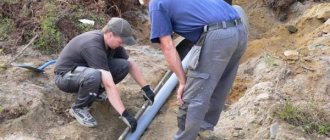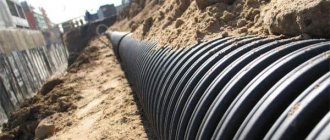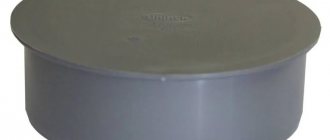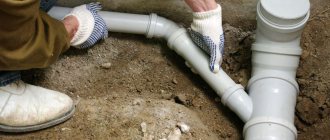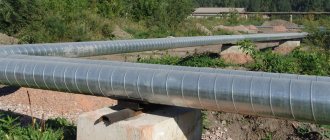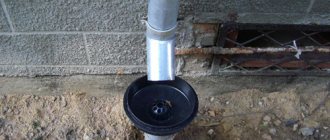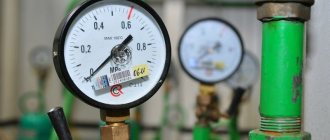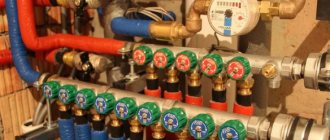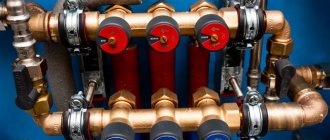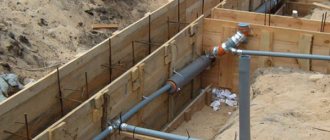We carry out installation and laying of internal and external communications of water supply and sewerage systems:
- For objects:
- A private house
- Apartment building (Building)
- Apartment
- Vacation home
- Country house
- Industrial buildings
- Office buildings
- Types of sewerage:
- Central
- Stormwater
- Autonomous
- Septic tank
- Types of water supply:
- Cold
- Hot
- Central
- Autonomous (From a well)
- Fire protection
- Negotiable
- For watering
carries out the entire cycle of work on the creation of engineering communications, including the installation of water supply and sewerage systems in Moscow and the Moscow region. The company's engineers and installers are distinguished by a high level of professional training, so customers are always satisfied with the results of our work.
Prices for installation of water supply and sewerage
* Our installation prices indicated in the price list are average and may vary depending on the scope of work and installation conditions. ** For a detailed calculation of the cost of installing internal water supply systems, you must contact the installation department. ***Full price list is available upon request.
| Installation work of hidden devices and communications | |||
| 1 | Installation and connection of the distribution manifold | PC | 4500 |
| 2 | Installation of installation for bidet, toilet, etc. | PC | 3500 |
| 3 | Installation of a built-in faucet | PC | 3500 |
| 4 | Installation of a built-in mixer with thermostat | PC | 4500 |
| 5 | Gangway installation | PC | 4000 |
| 6 | Connecting the 1st point of water or sewerage with laying pipelines throughout the sanitary room | PC | 1800 |
| 7 | Insertion of sewerage into the common house riser part (cast iron riser) | PC | 4500 |
| 8 | Insertion of sewerage into the common house riser (PVC riser) | PC | 4500 |
| Installation work of open devices | |||
| 1 | Installing a drain button for installation | PC | 1200 |
| 2 | Installation of a wall-hung toilet, bidet, etc., for installation | PC | 2200 |
| 3 | Installing and connecting the toilet to the floor | PC | 2200 |
| 4 | Installing a high-sided toilet | PC | 2200 |
| 5 | Installation of a water heated towel rail | PC | 5000 |
| 6 | Installation of a cast iron bathtub. | PC | 3500 |
| 7 | Installation of an acrylic bathtub. | PC | 3500 |
| 8 | Installation and connection of a jacuzzi. | PC | 7500 |
| 9 | Installation and connection of a hygienic shower | PC | 1400 |
| 10 | Installation of a shower cabin | PC | 12000 |
| 11 | Installation and connection of a washing machine with dryer | PC | 2200 |
| 12 | Installation and connection of a washing machine or dishwasher (without facade canopy) | PC | 1500 |
| 13 | Installation of an electric heated towel rail | PC | 2000 |
| 14 | Installing a shower head rod | PC | 800 |
| 15 | Installation of a built-in shower head | PC | 1400 |
| 16 | Installation of faucet (sink). | PC | 1400 |
| 17 | Installation of mixer with shower head. | PC | 1400 |
| 18 | Installation of a mixer with a thermostat. | PC | 2500 |
| 19 | Installing a sink on the wall | PC | 3500 |
| 20 | Installing a sink above a washing machine | PC | 3500 |
| 21 | Installing a sink on a cabinet or countertop (without a sash) | PC | 2000 |
| 22 | Installing a sink siphon | PC | 800 |
| 23 | Installing a siphon in the bathroom (drain and overflow) | PC | 1600 |
| 24 | Ball valve installation | PC | 600 |
| 25 | Installation of a DHW, cold water meter | PC | 1500 |
| Installation and dismantling work | |||
| 1 | Dismantling the toilet | PC | 1600 |
| 2 | Dismantling a toilet with opening of the drain pipe | PC | 3500 |
| 3 | Removing a water heated towel rail | PC | 1000 |
| 4 | Replacing towel pads | PC | 1200 |
| 5 | Dismantling a cast iron bathtub (without disposal) | PC | 3500 |
| 6 | Dismantling a steel acrylic bathtub (without disposal) | PC | 3500 |
| 7 | Dismantling the mixer (wall-mounted). | PC | 800 |
| 8 | Removing the faucet (under the sink). | PC | 800 |
| 9 | Removing the sink | PC | 2500 |
| 10 | Dismantling 1-point | PC | 400 |
| 11 | Dismantling/installation of 1-point (without laying a new supply pipe) | PC | 1200 |
| 12 | |||
| Complex installation work | |||
| 1 | Boiler piping up to 200 l. | PC | 7500 |
| 2 | Crimping of the boiler (with a conclusion of visible defects and submission of a crimping certificate) | PC | 5000 |
| 3 | Crimping of a house up to 300 m2 (with a conclusion of visible defects and submission of a crimping certificate) | PC | 15000 |
| 4 | Crimping of the riser part (with the conclusion of visible defects and submission of the crimping certificate) | PC | 5000 |
| 5 | Installation of water input unit | PC | 5200 |
| 6 | Electric boiler maintenance | PC | 4500 |
| Construction works | |||
| 1 | Brick chipping 30x30 | m. | 700 |
| 2 | Scoring on concrete 30x30 | m. | 1000 |
| 3 | Brick chipping 50x50 | m. | 1000 |
| 4 | Scoring on concrete 50x50 | m. | 2000 |
| 5 | Brick chipping 1100x110 | m. | 2200 |
| 6 | Scoring on concrete 110x110 | m. | 5000 |
| 7 | Punching holes d.45-55 on brick with clay up to 0.5 m. | PC. | 800 |
| 8 | Punching holes d.45-55 in concrete with clay up to 0.5 m. | PC. | 1500 |
Water supply and sewerage
Water supply
The Celsis company successfully carries out both the creation of internal water supply and sewerage systems with insertion into central communication highways, and the installation of autonomous systems.
Installation of internal sewerage and water supply
The creation of internal sewer and water mains includes:
- device for water distribution and metering installation;
- equipment for the riser (main vertical pipeline) of the sewerage system;
- installation of sewerage and water supply pipes;
- installation of a water heating boiler (if necessary);
- arrangement of water intake points and sewer drains.
Installation of external sewerage and water supply
External water supply and sewerage communications are:
- outdoor pipelines;
- inspection, rotary, drop and other wells;
- septic tanks and treatment facilities;
- well or borehole for drawing water.
Types of communications
The cost of installation of water supply and sewerage depends on the complexity of the systems and the materials and equipment used.
Connection to central networks of hot water supply, hot water supply and sewerage is, of course, preferable, but in suburban areas they simply do not exist. In this case, autonomous water supply and sewerage networks are created. According to the method of supplying liquids, pipelines can be non-pressure (in which the liquid moves by gravity, due to the slope of the pipeline) and pressure (they use pumps). Pumping equipment used to create autonomous water supply and sewerage includes the following types of pumps:
- superficial;
- submersible;
- sewer (fecal).
The installation of an autonomous sewerage system necessarily includes the equipment of a septic tank (sewage treatment plant). You can find the price list for sewerage installation in the corresponding section on the Celsis website.
External sewerage 110 mm - or how to choose pipes for external sewerage
External sewerage 110 mm is a fairly common request among those who plan to equip a wastewater treatment system - this is the diameter of the pipes that is most common for creating drainage lines in private homes. In addition, you can find proposals for external sewerage 160 mm, as well as other sizes, which is due to the peculiarities of designing engineering systems. Briefly, different diameters are needed in the following situations:
- Up to 100 mm – pipes used for laying internal sewerage.
- 110 mm is the most popular size of external sewer pipe in country houses using autonomous wastewater treatment systems.
- 160 mm - rarely used in individual construction of sewer systems, however, if the house is located within the city and it is possible to connect to a centralized sewer system, these pipes can be used in accordance with the given specifications.
In addition to the diameters of the pipes, the material from which they are made is also important. Note that today the most profitable in terms of both cost and durability is polyvinyl chloride. It is from this material that pipes are made for internal sewerage (usually gray) and for external mains (usually orange).
PVC pipes usually have convenient sockets for creating tight connections, in addition, they are easy to cut, they can be welded and, in general, they are easy to install and convenient to use. Perhaps the only drawback of such pipes is thermal conductivity, I would like it to be lower, but until such pipes are invented, it is advisable to insulate the main line from PVC pipes (and experts recommend insulating even its pipe located below the theoretical level of soil freezing - just in case).
Note that it is almost impossible to continue the external sewer line from one solid pipe, which means you will have to think about the tightness of the connection areas and minimal movement of the pipes under the influence of soil. To reduce the risk of depressurization during soil movement, it is recommended to equip a sand cushion at the bottom of the trench in which the main line is laid, as well as carry out initial backfilling with sand, and after backfilling the trench with soil, compact it along the edges (on the side of the pipe; with pressure from above on the pipe, it may not withstand load and crack).
Design and installation
Before concluding a contract, the company’s engineers visit the site and make the necessary measurements and studies. Based on them, an engineering project is made. It is a package of documents that includes:
- technological calculations
- graphic documents (diagrams and detailed drawings);
- specification of basic and consumable materials, as well as equipment;
- estimate documentation.
The work schedule and cost of turnkey water supply installation are determined. After agreeing on the project with the customer or his representative, work on the installation of pipelines and other equipment is carried out. Celsis installers comply with technological and sanitary standards and work carefully and quickly. Upon completion of installation work, appropriate tests are carried out and all elements are checked for leaks. At all stages of work, quality monitoring is carried out by process engineers.
High professionalism and modern technical equipment allow Celsis to maintain reasonable prices for installation of water supply and sewerage systems, even in times of crisis. We guarantee our work and do it conscientiously. The company has developed relationships with suppliers of quality equipment, so you will be offered an option that is best suited for your home. You can order installation services right now - our managers are always at your service.
Reviews about the company
Network composition
Various sources can be used for water supply. There are social and autonomous types. Public ones have high power and are capable of providing water to large settlements. Autonomous are wells or wells designed to supply a certain, relatively small number of consumers.
The public complexes include:
- main lines or water intake;
- stationary treatment plant with a preparation complex;
- pumping station providing standard pressure in pipes;
- system of pipes, wells, shut-off valves, and other technological components.
Sewage systems are also divided into public and autonomous. The first has a branched structure, largely replicating the water supply network. Installation of sewerage networks is carried out according to our own standards, of which sanitary requirements come first. The drainage systems include:
- pipeline complex;
- wells for one purpose or another (inspection, rotary, extinguishing, differential);
- pumping stations;
- open trays (for rain nets);
- filters, sand traps, settling tanks.
Treatment facilities are also part of the sewer system, but form a separate group of structures. In autonomous systems of private houses, waste disposal is carried out independently. There are structures that accumulate wastewater, but require periodic pumping. There are more modern installations that can process organics partially or completely. They are built according to their own rules, which cannot be ignored.
Also read: Dry toilet in a house without sewerage: what it looks like, how it works, advantages and disadvantages
Water treatment
Another extremely important point when installing water supply is water treatment, which involves performing special technical operations to process incoming water in order to bring its quality characteristics into compliance with established sanitary standards and consumer requirements.
This includes:
- water clarification,
- cleaning from mechanical impurities,
- demineralization,
- disinfection and disinfection,
- adjustment of acidity and alkalinity indicators, etc.
For this purpose, we install special highly efficient filter mechanisms.
